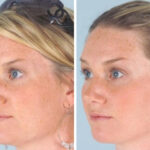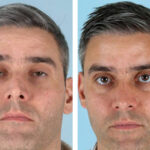Rhinoplasty | Houston
Rhinoplasty is the clinical term for nose surgery. A rhinoplasty can change your nose, removing imperfections or simply making it more proportional with the rest of the face. The nose is one of the most predominant features of the human face. When someone is unhappy with their nose it's often the only thing they can see. We want to help with that.
Rhinoplasty is one of the original cosmetic surgeries, first performed in the United States in 1887. The surgery involves making incisions to access the underlying bone and cartilage. Depending on your goals, your surgeon may remove some bone and cartilage, or he may add tissue. Once he has altered the underlying structure of the nose, the skin and tissue is re-draped over the new structure.
Nose surgery is a delicate procedure, and our surgeons take great pride in their ability to give our patients the nose they’ve wanted. This procedure can really change a patient’s self image.
Goals of Rhinoplasty
Every nose is different. How you see your nose now, and how you want to see it is a huge part of the process of getting a rhinoplasty. Goals may include enhancing breathing performance as well as improving appearance. Rhinoplasty can involve modifying skin, cartilage, bone, or all three.
During rhinoplasty, your surgeon may attempt to do one or more of the following:
- Modify the bridge
- Open breathing passages
- Reshape the tip
- Remove a hump
- Reshape or resize the nostrils
- Repair an injury
- Reshape or resize the nostrils
- Increase or decrease size
If you are concerned about keeping ethnic traits of your nose while changing others, you may want to consider ethnic rhinoplasty.
How The Procedure Works
There are two methods to rhinoplasty: closed or open. During your consultation, your surgeon will discuss which method he believes fits your needs. This will be a joint decision.
In open rhinoplasty, your surgeon makes an incision across the columella, the sliver of tissue between your nostrils. The soft tissue is then lifted upward and off the bone and cartilage. The open method completely exposes the underlying structure, making more dramatic modifications possible. After your surgeon reshapes the bone or cartilage, the soft tissue is then brought back down.
In closed rhinoplasty, your surgeon will make all of the necessary incisions inside the nose. This method makes no visible scarring, but it can limit the extent of reshaping possible.
If your goal is to build up an area of the nose, your surgeon can take cartilage or other material from the septum, the ears, or a rib. Sometimes we use synthetic implants.
If you are looking to shrink the size of your nose, your surgeon may break the nasal bones.
Rhinoplasty Gallery
Please click a before and after photo to enlarge. Photos are of actual Cilento Facial Plastics patients and are shared with permission. ©Cilento Facial Plastics
Am I A Candidate For Rhinoplasty?
When a patient comes to us exploring the possibility of nose surgery, there are usually three main purposes: cosmetic issues, injury repair, or to improve function.
Cosmetic
If a person feels their nose is too bulbous or there’s a bump on the bridge, it can be a real issue. Here are common aesthetic reasons patients seek to make some changes:
• Their nose is too big or too small.
• The nose droops downward.
• They have overly flared nostrils.
• The nose isn’t proportional with the rest of the face.
• There is a prominent bump on the bridge.
• The nose has a bulbous tip.
• The nose is too wide or flat.
• Their nose is crooked from a prior injury.
Injury
People often injure their nose, but don’t always opt to correct it. Things like touch football games or even bumping into a wall in a dark room can alter the look and the function. We can correct both the appearance and the function.
Function
Some people are born with nasal passages that are too narrow. Restricted airflow can lead to snoring and even sleep apnea. Functional Rhinoplasty can open constricted airways and vastly improve breathing function.
Rhinoplasty Results
A good rhinoplasty result can completely change a person’s image. The nose is the central and most prominent feature of the face. A well executed rhinoplasty will draw less attention to a person’s nose, not more. Many of our patients say after rhinoplasty they receive many compliments on their eyes. When the nose is less prominent, other features come to the foreground.
It is important for our patients to understand there is no such thing as a ‘perfect’ surgical result. Nowhere is this more evident than in rhinoplasty. As a patient, you should be very skeptical of any surgeon that promises perfection or treats the outcome as a foregone conclusion. In skilled hands there is an excellent chance of success, however, rhinoplasty is one surgery in which there is an element of unpredictability. This is why the postoperative period is so critical, a time when the patient must adhere carefully to a strict regimen.
Rhinoplasty Risks
There are the general risks that accompany any surgery: anesthesia reaction, infection, bleeding, poor wound healing, scarring, and changes in skin sensation. Specific to this procedure, the patient may have difficulty breathing, skin discoloration and continued swelling, possible perforation of the nasal septum, or unsatisfactory final results. If further changes are necessary, revision surgery may be an option.
Schedule Your Consultation Today
If you've ever considered rhinoplasty, a consultation is the first step! If you'd like to chat with someone before booking please call us at 346-413-9313 or fill out the form below and we'll reach out to you.
Recovery After Rhinoplasty
Part of our process is making sure you feel comfortable and prepared for post op.
When your surgery is complete, we will pack your nose will your surgeon will place a splint on it. This splint will stay in place for about one week. Swelling and bruising are common. This is inevitable with the degree of tissue trauma as a result of rhinoplasty. A cold compress can help.
For the first week, you will need to keep your head elevated as much as possible, even when sleeping. You can expect bruising and swelling near the area around your eyes and nose. This usually lasts for 10-14 days.
If you wear glasses, you will need to tape them to your forehead for up to seven weeks to keep any pressure off of your nose. Any strenuous exercise or lifting that increases blood flow to the face needs to be strictly avoided for several weeks.





























